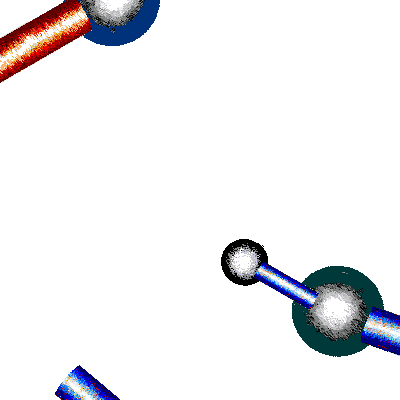
GIF made with screen capture from the Rotor 34 - HyperMolecules page
(thanks again to Duncan Alexander for automating my atomic vocabulary - he saved me years of work)

GIF made with screen capture from the Rotor 34 - HyperMolecules page
(thanks again to Duncan Alexander for automating my atomic vocabulary - he saved me years of work)
Am re-reading passages from File Under Popular, 1985, a self-published book of music theory by the ex-Henry Cow drummer and RIO (rock in opposition) figurehead Chris Cutler. From a great essay on Sun Ra (heavily redacted for brevity but with an attempt to preserve the typographical quirks), pages 76-77:
Ra recognizes from the start that electronic instruments are not merely acoustic instruments writ large; they are new instruments with their own inherent qualities and implications... The core of these "hidden" intrinsic properties lies in the realm of sound--sound which must be liberated. It will be discovered not by pen, through the score of the "composer," but in the ear & the testing imagination of the player... Only then can that creative conflict between instrument and player be engendered & pursued. What is "normal" is for musicians to imitate - the old licks & old players - to "master" the old vocabulary... In such cases...the instrument is in fact dominating the player. The layout of the instrument & the cultural history of its use has made deep grooves which the fingers follow--it has made habitual synapse-paths in the player's brain. By rehearsing and strengthening those grooves and paths, the player may believe that he or she is becoming the instrument's master... In fact, this player is tightening the bonds of his or her own slavery. [bold is underscored in the original]
Liberation rhetoric aside, the concept of "the ear and the testing imagination of the player" deserves more of a place in musical discussion. It's said of painting that the only way to be a painter is to paint and look at paintings; that could also be the case for electronic musicians and electronic music, not because a practice needs to be mastered but because the field is so vast and wide open, with new hardware and software appearing daily.
Am reading and enjoying Michel Chion's book Audio-Vision, a treatise on sound in cinema by a critic, musician, and former student of musique concrète composer Pierre Schaffer's. A few notes on pages 136-7 [bracketed language is my paraphrasing]:
Rhythm...is an element of film vocabulary that is neither...specifically auditory or visual.
...the phenomenon strikes us in some region of the brain connected to the motor functions....
[either the eye or ear could be the path to that region]
My basic thesis on transsensorial perception applies [also] to perceptions of texture and material as well, and surely to language...
Transsensoriality has nothing to do with intersensoriality, as in the famous "correspondences" among the senses that Baudelaire, Rimbaud, Claudel and others have celebrated.
...the senses are channels, highways [as opposed to "territories or domains" which have specific sensations assigned to them, such as color in the eye or pitch in the ear].
When kinetic sensations organized into art are transmitted through a single sensory channel...they can convey all the other senses at once. The silent cinema on the one hand [say, in a use of fluid and rapid montage] and musique concrète on the other illustrate this idea. Concrete music, in its conscious refusal of the visual, carries with it visions that are more beautiful than images ever could be.